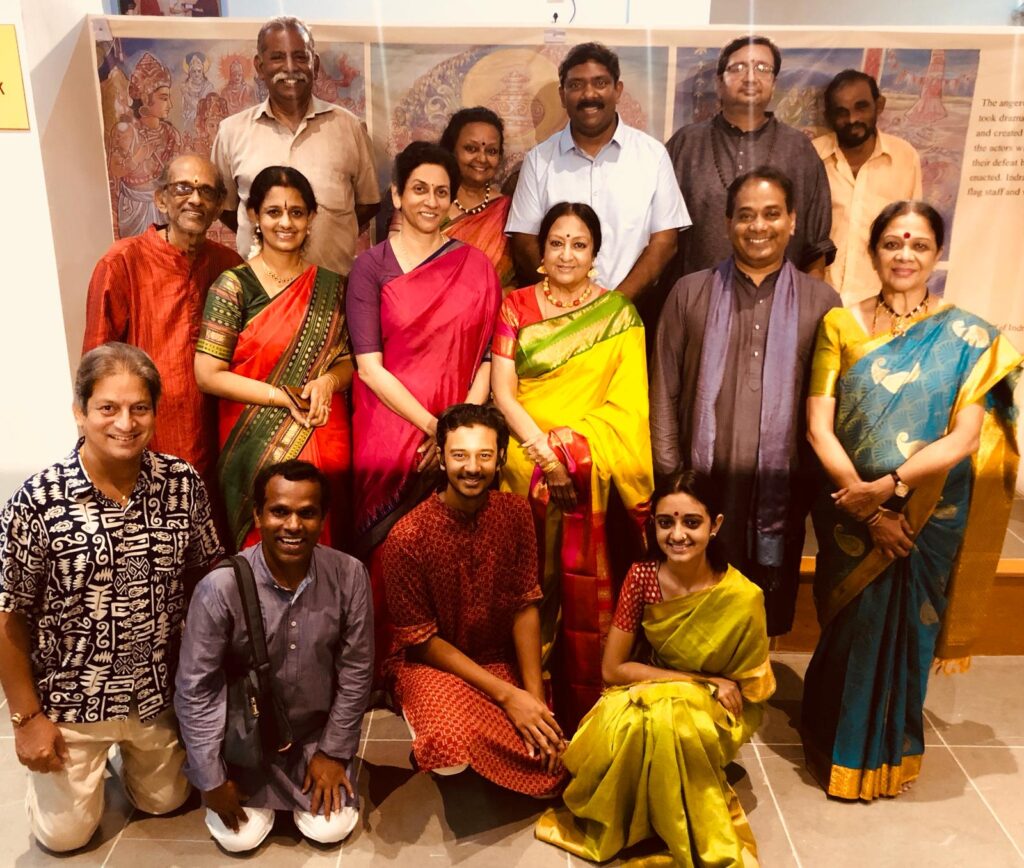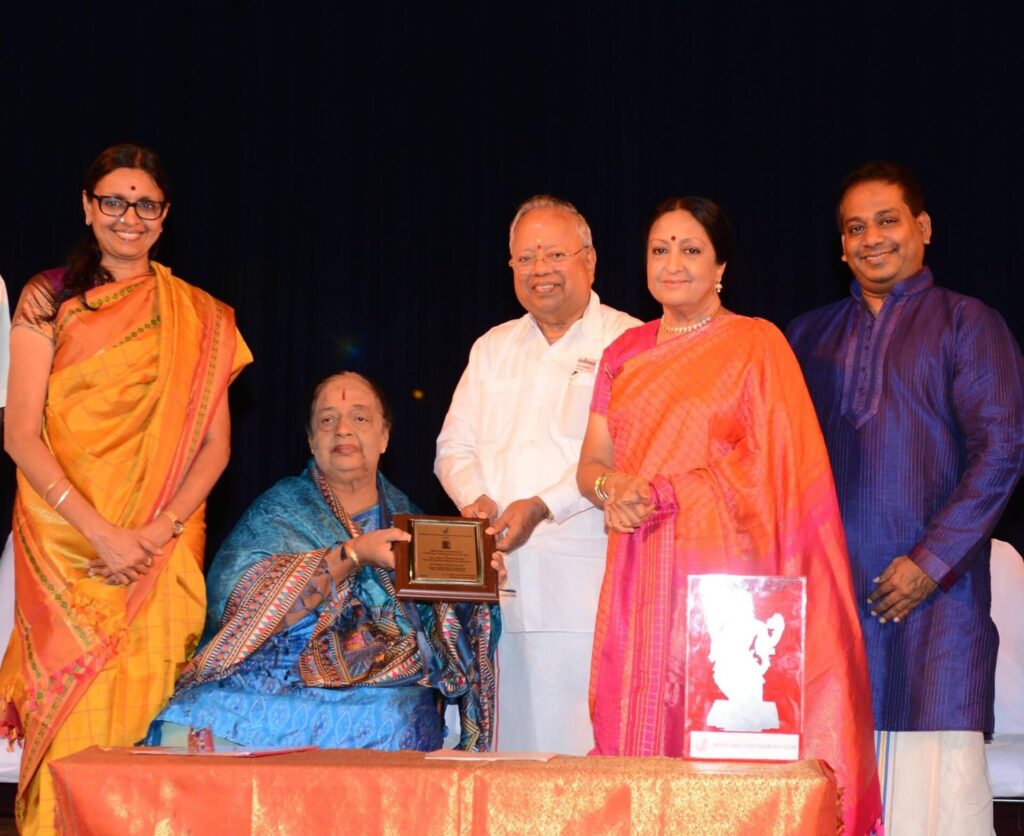Bharatanatyam exponent, research scholar, writer, teacher and founder of the Bharatamuni Ilango Foundation for Asian Culture (BIFAC), goes back in time and recalls some precious moments that reinforce her long-standing relationship and friendship with Apsaras Arts, its founders and current Artistic Director, Aravinth Kumarasamy

Can you go back a little in time and tell us about your association with Neila (Sathyalingam) Maami and Sathyalingam Maama.
Actually, to start from the very beginning, my father knew Sathyalingam’s father. He was a big shot in Sri Lanka, a Minister of sorts. Thinking of it, our friendship began when Neila and Sathy (as we called him) were students at the Kalakshetra; my father had presided over their performance. I was a very young girl then but I distinctly remember Neila’s costume – a saree with a neatly pleated fan that was drawn towards the back. It really appealed to me. I was charmed both by Neila’s dance and her dress.
Our family knew Sathyalingam’s family also very well. I had performed in Singapore for the Indian Fine Arts but when Neila was representing the Singapore Arts Festival, she invited me to choreograph the Valli Kalyanam piece for her; it was exciting because all the dancers and the entire orchestra had to comprise of artistes from Singapore. I was the only one from India and I had been entrusted with the responsibility of choreographing it as well as composing music for it. I was excited no doubt but I insisted that it would be great to also include Chinese dancers alongside Indian dancers and really make it a celebration of the dance fraternity of Singapore. I remember Neila being quite thrilled by this idea.
Until then, the artistes of Singapore had never collaborated or performed together. I was proud to have made it happen with Neila’s support. We had a thirteen-member orchestra that also included Chinese musicians; Sathy was on the nattuvangam; Karaikudi Krishnamurthy was on the mridangam and Aravinth (Kumarasamy) played the veena. That’s when I first met Aravinth in the late 70s.
I remember spending 20 days in Singapore leading up to the production and despite the initial hiccups, it all came together very well.
That’s how it all began…
Honestly, that’s the thing about Neila! She was, right from the start, very open-minded and creative; she always kept her eyes open to everything that happened around the world.
In that sense, Neila and Sathy were a couple who were made for each other.





















That’s a great story; tell us more…
My connection with Apsaras Arts kept growing, year on year. A few years later, a student of mine moved to Singapore and learnt dance further at Apsaras. Anytime someone from Singapore came to Chennai, they’d come over to study dance with me.
In the 80s, I went to Singapore for yet another performance.
The theme, this time, was around the idea of Seasons.
I didn’t have much time to spend in Singapore but I worked closely with the musicians there including the Chinese and the Indonesians; I composed the music and did a rough recording for them. Thereafter, I allocated the parts to be choreographed by Apsaras Arts and other dance schools and provided them with an overall framework.
What was interesting about this production was that I composed a special Thillana for this work; a raga-thalamalika wherein I took inspiration from the Asian pentatonic scale, which has only five notes. Having studied Ethnomusicology in my Masters, I used the concept of the Graha Bedham and composed a Thillana that featured five different ragams in five different srutis.
I have to tell you that Apsaras Arts are still performing this Thillana, so many years later…
After we premiered Valli Kalyanam, I remember Aravinth joined Apsaras Arts and went on to become the adopted son of Neila and Sathy and he continues to carry forward their legacy.
In fact, through my institution, BIFAC, we conferred Neila an award titled ‘Bharatha Putri’, which has, so far, been given only to three people, the others being Professor KD Tripathi and Chemancheri Kunhiraman Nair.
I think it was also the last time Neila came to India….
Over the years, you have been associated with the DIAP and IPAC; do tell us a little bit about being a mentor for IPAC?
Every year artistes like Priyadarsini Govind and Rama Vaidyanathan have been conducting workshops as part of IPAC (Indian Performing Arts Convention) along with artistes from other dance forms too.
The thing is, Aravinth is a very broad-minded artiste and he is also very respected in the Singapore Arts Council, because of his straightforwardness and professionalism. I do believe that Apsaras Arts has grown significantly under his mentorship.
Aravinth often says that he is deeply influenced by my work.
When I went to Singapore for Valli Kalyanam, I kept telling Neila that Singapore, as a country, is really at the centre of Asia and has the possibility of bringing artistes from across Asia together and become a hub for Asian culture. I think Aravinth is seeing through this idea through the many initiatives, events and productions that come from the house of Apsaras Arts.
In fact, the first time Aravinth explored Cambodia was with me and my family. This was way before he went on to create the production inspired by Angkor Wat. In 2009. Aravinth wanted to travel with me to explore the sculptures of the temples in Cambodia.
I was presenting a lecture at the Royal University of Phnom Penh and had interacted with the local artistes there. I demonstrated to them how the Natya Shastra has links with what we are all doing with our dance. Aravinth was there watching and taking notes all the time. On the same trip,I also had the honour of meeting the Princess Buppha Devi, whose mother, the Queen Mother, actually gave the name, Apsara to the dance of Cambodia. I interacted with them and could see how Bharata was still alive.
For instance, Bharata’s mask continues to be worshipped in Cambodia. Buppha Devi asked me to go and see a beautiful mask, which was kept in a museum. They opened the museum exclusively for me on a Sunday and Aravinth was also with me that day.
Unfortunately though I haven’t yet had the opportunity to watch Angkor, a production Aravinth went on to create. But Gayatri’s voice was used for the sections performed by Priyadarsini Govind and all of that was recorded here in Chennai.
What according to you are the striking features of the productions of Apsaras Arts?
I’d like to say that their productions have a quality that is holistic about them. For instance,I have watched Anjaneyam. In it, the ambience, lighting, choreography and elements of theatre come together in such a grand and powerful way that I sometimes wonder, if we in India can ever recreate that. We don’t have the kind of technical facilities they do, abroad.
Yet another production I have watched is Amara in which Mahati (Kannan) danced alongside Apsaras Arts’ Principal Dancer and Choreographer, Mohanapriyan. This premiered a few years ago at the Kalakshetra.
It’s lovely, right, that dancers from India and Singapore can connect and come together for productions…
Yes, I think it is very healthy and the way forward. I sincerely believe that the arts can bring people together. There is a lot of give and take in the arts and artistes need to learn to shed their ego and work together.
As an artiste, it is difficult to assimilate anything if you are full of yourself. Only when you let go of your ego, can you start really appreciating each other.
I’d like to think that in that sense, I am basically a rasika.
Apsaras Arts also creates and publishes a whole host of books; what is your take on them?
Every book of Apsaras has been extraordinary, both in terms of content, quality of photographs, design and overall production values.
Even their exhibitions are nothing short of marvellous.
Last year for instance, during the season of music and dance, for the premiere of Arisi: Rice, they researched so deeply and presented an exhibition that allowed people to understand and appreciate the process, the costumes and what went behind-the-scenes.
Their aesthetics are amazing and thanks to their holistic approach in handling every production, the overall experience becomes meaningful and intellectual both for the artiste and the audience.









